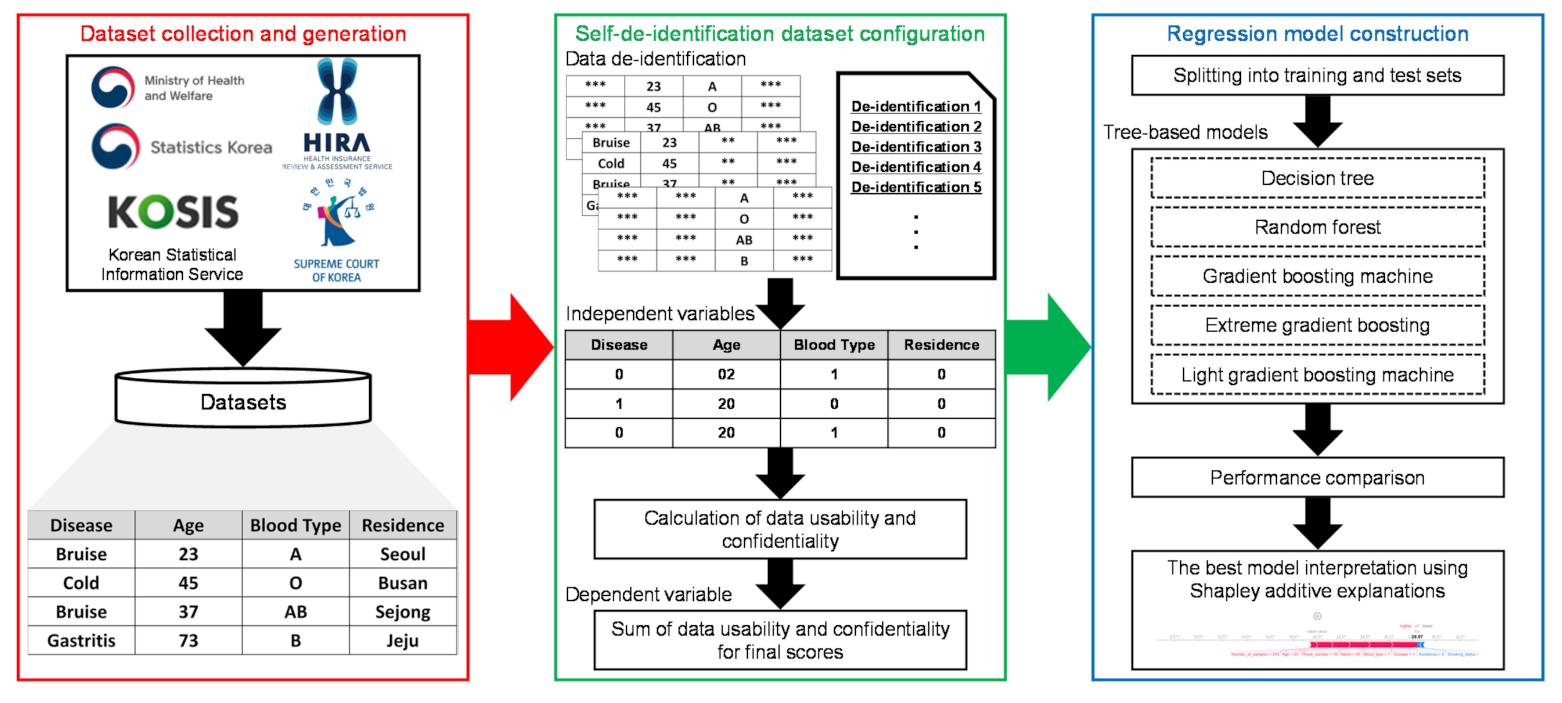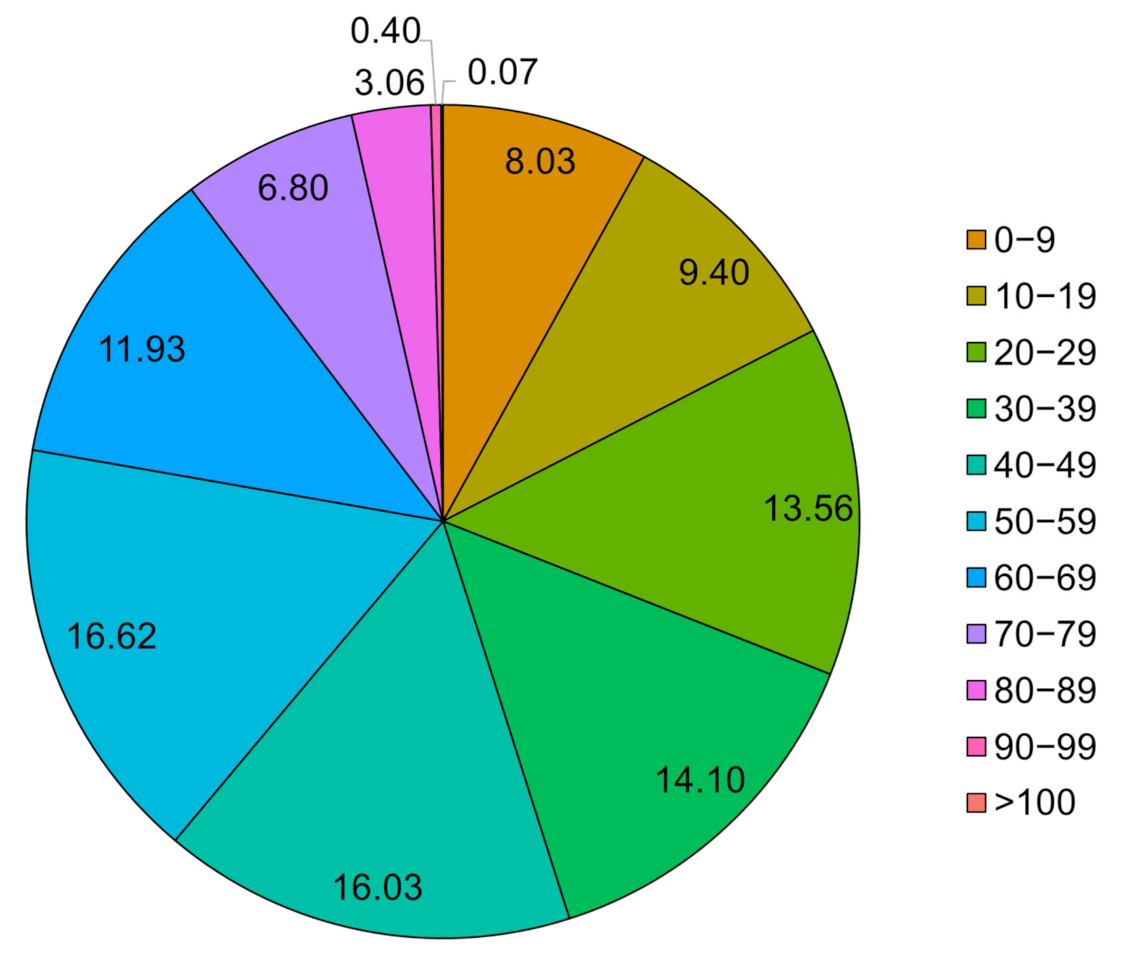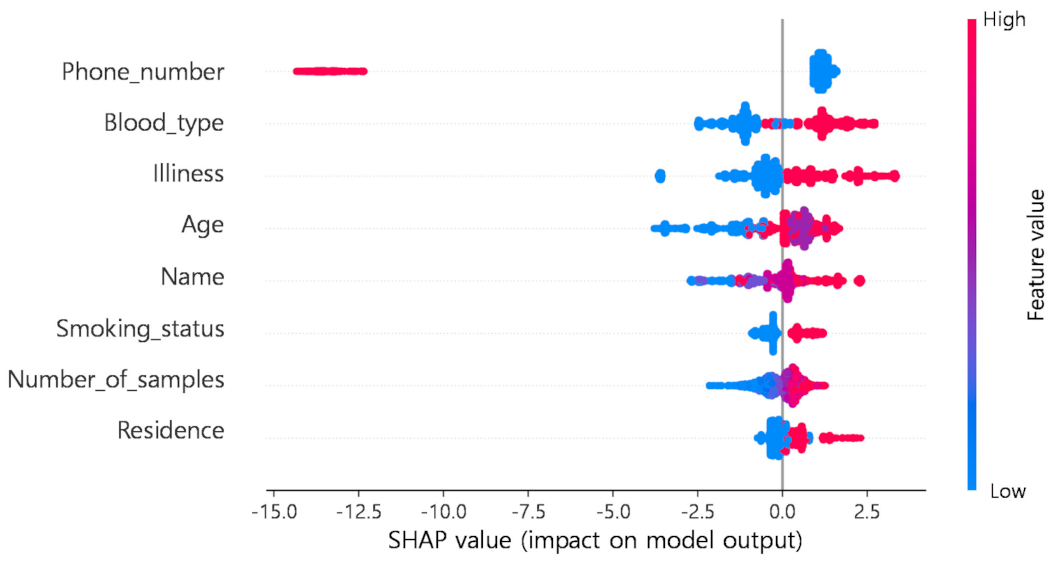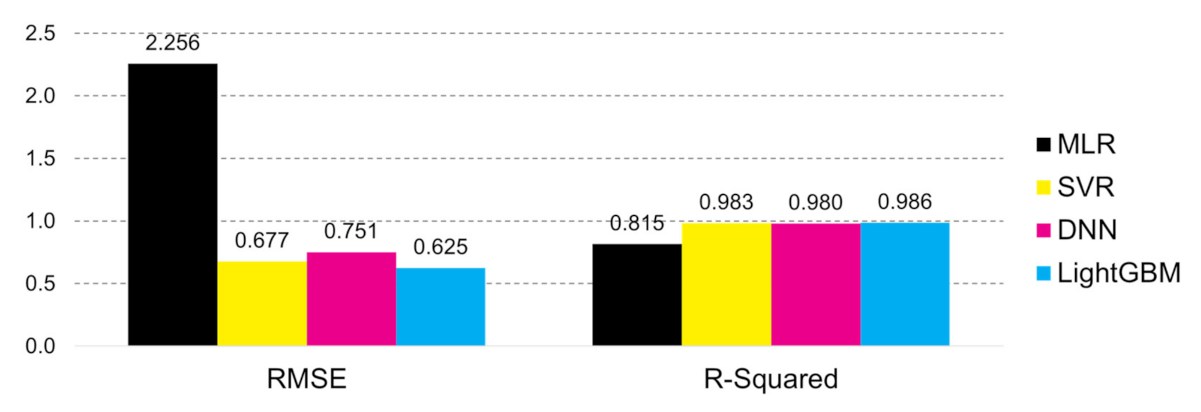Verification of De-Identification Techniques for Personal Information Using Tree-Based Methods with Shapley Values
Abstract
:1. Introduction
- A generated dataset based on medical data for model training is configured, exhibiting a distribution similar to the actual personal information dataset by considering the actual statistical results for South Korea, including the name, residential area, and age.
- Data preprocessing is performed for the self-de-identification dataset and simulation models using DT-based methods constructed for training various de-identification datasets, and their performance is compared to confirm superior models in terms of privacy.
- An XAI technique is used to interpret the process of model training to present the process for determining an appropriate de-identification methodology that can assist in developing a de-identification methodology or modifying policies in the future.
2. Related Work
2.1. Data Usability
2.2. Data Confidentiality
3. Materials and Methods
3.1. Data Generation
3.1.1. Name
3.1.2. Age
3.1.3. Phone Number
3.1.4. Residential Area
3.1.5. Illness
3.1.6. Blood Type
3.1.7. Smoking Rate
3.2. Data Preprocessing
3.2.1. Name
3.2.2. Age
3.2.3. Phone Number
3.2.4. Other
3.2.5. Data Usability
3.2.6. Data Confidentiality
3.2.7. Final Score
3.3. Model Construction
4. Results
4.1. Experimental Design
4.2. Performance Indicator
4.3. Hyperparameter Tuning
4.4. Performance Comparison
4.5. Model Interpretation
- Phone number: The lower the value, the higher the expected score.
- Blood type: The higher the value, the higher the expected score.
- Illness: The higher the value, the higher the expected score.
- Age: The higher the value, the higher the expected score.
- Name: The higher the value, the higher the expected score.
- Smoking status: The higher the value, the higher the expected score.
- Number of samples: The higher the value, the higher the expected score.
- Residence: The higher the value, the higher the expected score.
4.6. Discussion
5. Conclusions
Author Contributions
Funding
Institutional Review Board Statement
Informed Consent Statement
Data Availability Statement
Conflicts of Interest
References
- Hashem, I.A.T.; Yaqoob, I.; Anuar, N.B.; Mokhtar, S.; Gani, A.; Khan, S.U. The rise of “big data” on cloud computing: Review and open research issues. Inf. Syst. 2015, 47, 98–115. [Google Scholar] [CrossRef]
- Long, W.J.; Quek, M.P. Personal data privacy protection in an age of globalization: The US-EU safe harbor compromise. J. Eur. Public Policy 2002, 9, 325–344. [Google Scholar] [CrossRef]
- Zyskind, G.; Nathan, O. Decentralizing privacy: Using blockchain to protect personal data. In Proceedings of the 2015 IEEE Security and Privacy Workshops (SPW), San Jose, CA, USA, 21–22 May 2015; pp. 180–184. [Google Scholar]
- Shin, S.-Y. Privacy Protection and Data Utilization. Healthc. Inform. Res. 2021, 27, 1–2. [Google Scholar] [CrossRef] [PubMed]
- Korea Legislation Research Institute. Act on Promotion of the Provision and Use of Public Data. Available online: https://elaw.klri.re.kr/eng_mobile/viewer.do?hseq=47133&type=part&key=4 (accessed on 25 December 2021).
- Korea Legislation Research Institute. Personal Information Protection Act. Available online: https://elaw.klri.re.kr/eng_service/lawView.do?hseq=53044&lang=ENG (accessed on 25 December 2021).
- Gilbert, G.L.; Degeling, C.; Johnson, J. Communicable Disease Surveillance Ethics in the Age of Big Data and New Technology. Asian Bioeth. Rev. 2019, 11, 173–187. [Google Scholar] [CrossRef] [PubMed] [Green Version]
- Ienca, M.; Vayena, E. On the responsible use of digital data to tackle the COVID-19 pandemic. Nat. Med. 2020, 26, 463–464. [Google Scholar] [CrossRef] [Green Version]
- Yang, X.; Lyu, T.; Li, Q.; Lee, C.-Y.; Bian, J.; Hogan, W.R.; Wu, Y. A study of deep learning methods for de-identification of clinical notes in cross-institute settings. BMC Med Inform. Decis. Mak. 2019, 19, 1–9. [Google Scholar] [CrossRef] [Green Version]
- Prasser, F.; Kohlmayer, F.; Lautenschläger, R.; Kuhn, K.A. ARX—A Comprehensive Tool for Anonymizing Biomedical Data. In Proceedings of the AMIA Annual Symposium Proceedings, Washington, DC, USA, 15–19 November 2014; pp. 984–993. [Google Scholar]
- Prasser, F.; Kohlmayer, F. Putting Statistical Disclosure Control into Practice: The ARX Data Anonymization Tool. In Medical Data Privacy Handbook; Springer: Berlin/Heidelberg, Germany, 2015; pp. 111–148. [Google Scholar] [CrossRef]
- Dernoncourt, F.; Lee, J.Y.; Uzuner, O.; Szolovits, P. De-identification of patient notes with recurrent neural networks. J. Am. Med Inform. Assoc. 2016, 24, 596–606. [Google Scholar] [CrossRef]
- Neamatullah, I.; Douglass, M.M.; Lehman, L.H.; Reisner, A.; Villarroel, M.; Long, W.J.; Szolovits, P.; Moody, G.B.; Mark, R.G.; Clifford, G.D. Automated de-identification of free-text medical records. BMC Med. Inform. Decis. Mak. 2008, 8, 32. [Google Scholar] [CrossRef] [Green Version]
- Meystre, S.M.; Friedlin, F.J.; South, B.R.; Shen, S.; Samore, M.H. Automatic de-identification of textual documents in the electronic health record: A review of recent research. BMC Med. Res. Methodol. 2010, 10, 70. [Google Scholar] [CrossRef] [Green Version]
- Yogarajan, V.; Pfahringer, B.; Mayo, M. A review of Automatic end-to-end De-Identification: Is High Accuracy the Only Metric? Appl. Artif. Intell. 2020, 34, 251–269. [Google Scholar] [CrossRef] [Green Version]
- Kim, Y.; Jung, S.; Ji, S.; Hwang, E.; Rho, S. IoT-based personalized NIE content recommendation system. Multimed. Tools Appl. 2018, 78, 3009–3043. [Google Scholar] [CrossRef]
- Kim, Y.; Moon, J.; Hwang, E. Constructing Differentiated Educational Materials Using Semantic Annotation for Sustainable Education in IoT Environments. Sustainability 2018, 10, 1296. [Google Scholar] [CrossRef] [Green Version]
- Kim, J.; Moon, J.; Hwang, E.; Kang, P. Recurrent inception convolution neural network for multi short-term load forecasting. Energy Build. 2019, 194, 328–341. [Google Scholar] [CrossRef]
- Hussain, T.; Ullah, F.U.M.; Muhammad, K.; Rho, S.; Ullah, A.; Hwang, E.; Moon, J.; Baik, S.W. Smart and intelligent energy monitoring systems: A comprehensive literature survey and future research guidelines. Int. J. Energy Res. 2021, 45, 3590–3614. [Google Scholar] [CrossRef]
- Rew, J.; Cho, Y.; Moon, J.; Hwang, E. Habitat Suitability Estimation Using a Two-Stage Ensemble Approach. Remote Sens. 2020, 12, 1475. [Google Scholar] [CrossRef]
- Rew, J.; Park, S.; Cho, Y.; Jung, S.; Hwang, E. Animal Movement Prediction Based on Predictive Recurrent Neural Network. Sensors 2019, 19, 4411. [Google Scholar] [CrossRef] [Green Version]
- Koteluk, O.; Wartecki, A.; Mazurek, S.; Kołodziejczak, I.; Mackiewicz, A. How Do Machines Learn? Artificial Intelligence as a New Era in Medicine. J. Pers. Med. 2021, 11, 32. [Google Scholar] [CrossRef]
- Gazda, J.; Drotar, P.; Drazilova, S.; Gazda, J.; Gazda, M.; Janicko, M.; Jarcuska, P. Artificial Intelligence and Its Application to Minimal Hepatic Encephalopathy Diagnosis. J. Pers. Med. 2021, 11, 1090. [Google Scholar] [CrossRef]
- Qiu, B.; van der Wel, H.; Kraeima, J.; Glas, H.H.; Guo, J.; Borra, R.J.H.; Witjes, M.J.H.; van Ooijen, P.M.A. Automatic Segmentation of Mandible from Conventional Methods to Deep Learning—A Review. J. Pers. Med. 2021, 11, 629. [Google Scholar] [CrossRef]
- Kim, J.; Park, M.; Kim, H.; Cho, S.; Kang, P. Insider Threat Detection Based on User Behavior Modeling and Anomaly Detection Algorithms. Appl. Sci. 2019, 9, 4018. [Google Scholar] [CrossRef] [Green Version]
- Kim, J.; Kang, P. Freely typed keystroke dynamics-based user authentication for mobile devices based on heterogeneous features. Pattern Recognit. 2020, 108, 107556. [Google Scholar] [CrossRef]
- Vimal, S.; Robinson, Y.H.; Kaliappan, M.; Pasupathi, S.; Suresh, A. Q Learning MDP Approach to Mitigate Jamming Attack Using Stochastic Game Theory Modelling with WQLA in Cognitive Radio Networks. J. Platf. Technol. 2021, 9, 3–14. [Google Scholar]
- Shailaja, K.; Seetharamulu, B.; Jabbar, M.A. Machine Learning in Healthcare: A Review. In Proceedings of the 2018 Second International Conference on Electronics, Communication and Aerospace Technology (ICECA), Coimbatore, India, 29–31 March 2018. [Google Scholar]
- Kwon, B.C.; Choi, M.-J.; Kim, J.T.; Choi, E.; Kim, Y.B.; Kwon, S.; Sun, J.; Choo, J. RetainVis: Visual Analytics with Interpretable and Interactive Recurrent Neural Networks on Electronic Medical Records. IEEE Trans. Vis. Comput. Graph. 2018, 25, 299–309. [Google Scholar] [CrossRef] [Green Version]
- Gunning, D.; Aha, D. DARPA’s Explainable Artificial Intelligence (XAI) Program. AI Mag. 2019, 40, 44–58. [Google Scholar] [CrossRef]
- Adadi, A.; Berrada, M. Peeking Inside the Black-Box: A Survey on Explainable Artificial Intelligence (XAI). IEEE Access 2018, 6, 52138–52160. [Google Scholar] [CrossRef]
- Tjoa, E.; Guan, C. A Survey on Explainable Artificial Intelligence (XAI): Toward Medical XAI. IEEE Trans. Neural Networks Learn. Syst. 2021, 32, 4793–4813. [Google Scholar] [CrossRef] [PubMed]
- Lundberg, S.M.; Erion, G.; Chen, H.; DeGrave, A.; Prutkin, J.M.; Nair, B.; Katz, R.; Himmelfarb, J.; Bansal, N.; Lee, S.-I. From local explanations to global understanding with explainable AI for trees. Nat. Mach. Intell. 2020, 2, 56–67. [Google Scholar] [CrossRef] [PubMed]
- Park, S.; Moon, J.; Hwang, E. Explainable Anomaly Detection for District Heating Based on Shapley Additive Explanations. In Proceedings of the 2020 International Conference on Data Mining Workshops (ICDMW), Sorrento, Italy, 17–20 November 2020; pp. 762–765. [Google Scholar] [CrossRef]
- Bloland, P.; MacNeil, A. Defining & assessing the quality, usability, and utilization of immunization data. BMC Public Health 2019, 19, 380. [Google Scholar] [CrossRef]
- Silsand, L.; Severinsen, G.-H.; Pedersen, R. Structuring the Electronic Patient Record; An Easy Way to Improve Data Usability? In Proceedings of the 8th International Conference on Infrastructures in Healthcare (InfraHealth 2021), Kristiansand, Norway, 23–24 September 2021; pp. 1–10. [Google Scholar]
- Wait, A.D. The Importance of Data Reliability and Usability When Assessing Impacts of Marine Mineral Oil Spills. Toxics 2021, 9, 302. [Google Scholar] [CrossRef] [PubMed]
- Adnan, K.; Akbar, R.; Wang, K.S. Development of Usability Enhancement Model for Unstructured Big Data Using SLR. IEEE Access 2021, 9, 87391–87409. [Google Scholar] [CrossRef]
- Adnan, K.; Akbar, R.; Wang, K.S. Towards Improved Data Analytics Through Usability Enhancement of Unstructured Big Data. In Proceedings of the 2021 International Conference on Computer & Information Sciences (ICCOINS), Kuching, Malaysia, 13–15 July 2021; pp. 1–6. [Google Scholar]
- Javid, T.; Faris, M.; Beenish, H.; Fahad, M. Cybersecurity and Data Privacy in the Cloudlet for Preliminary Healthcare Big Data Analytics. In Proceedings of the 2020 International Conference on Computing and Information Technology (ICCIT-1441), Tabuk, Saudi Arabia, 9–10 September 2020; pp. 7–10. [Google Scholar]
- Domingo-Ferrer, J.; Muralidhar, K.; Bras-Amoros, M. General Confidentiality and Utility Metrics for Privacy-Preserving Data Publishing Based on the Permutation Model. IEEE Trans. Dependable Secur. Comput. 2021, 18, 2506–2517. [Google Scholar] [CrossRef]
- Yuan, Y.; Zhang, J.; Xu, W.; Li, Z. Enable data privacy, dynamics, and batch in public auditing scheme for cloud storage system. In Proceedings of the 2021 2nd International Conference on Computer Communication and Network Security (CCNS), Xining, China, 30 July–1 August 2021; pp. 157–163. [Google Scholar]
- Gai, K.; Qiu, M.; Zhao, H. Privacy-Preserving Data Encryption Strategy for Big Data in Mobile Cloud Computing. IEEE Trans. Big Data 2021, 7, 678–688. [Google Scholar] [CrossRef] [Green Version]
- Bakır, C. Single Label Model for Confidentiality in Big Data. In Proceedings of the 2021 6th International Conference on Computer Science and Engineering (UBMK), Ankara, Turkey, 15–17 September 2021; pp. 10–14. [Google Scholar]
- Santos, R.J.; Bernardino, J.; Vieira, M. A Data masking technique for data warehouses. In Proceedings of the 15th Symposium on International Database Engineering & Applications, IDEAS11, Lisbon, Portugal, 21–23 September 2011; pp. 61–69. [Google Scholar]
- Ali, O.; Ouda, A. A classification module in data masking framework for Business Intelligence platform in healthcare. In Proceedings of the 2016 IEEE 7th Annual Information Technology, Electronics and Mobile Communication Conference (IEMCON), Vancouver, BC, Canada, 13–15 October 2016; pp. 1–8. [Google Scholar] [CrossRef]
- Korean Legal Information Institute. Family Relationship. Available online: http://koreanlii.or.kr/w/index.php/Family_relationship (accessed on 25 December 2021).
- Wikipedia. List of Korean Surnames. Available online: https://en.wikipedia.org/wiki/List_of_Korean_surnames (accessed on 25 December 2021).
- Statistics Korea. Population Census. Population, Households and Housing Units. Available online: https://kosis.kr/statHtml/statHtml.do?orgId=101&tblId=DT_1IN1502&conn_path=I2&language=en (accessed on 25 December 2021).
- Statistics Korea. Population Statistics Based on Resident Registration. Resident Population in Five-Year Age Groups (2011~). Available online: https://kosis.kr/statHtml/statHtml.do?orgId=101&tblId=DT_1B04005N&conn_path=I2&language=en (accessed on 25 December 2021).
- Korean Red Cross. Blood Information Statistics. Available online: https://kosis.kr/statHtml/statHtml.do?orgId=445&tblId=DT_445001_006 (accessed on 25 December 2021).
- Statistics Korea. Social Survey. Smoking (19 Years Old and Over). Available online: https://kosis.kr/statHtml/statHtml.do?orgId=101&tblId=DT_1SSHE032R&conn_path=I2&language=en (accessed on 25 December 2021).
- Ahmadi, A.; Nabipour, M.; Mohammadi-Ivatloo, B.; Amani, A.M.; Rho, S.; Piran, J. Long-Term Wind Power Forecasting Using Tree-Based Learning Algorithms. IEEE Access 2020, 8, 151511–151522. [Google Scholar] [CrossRef]
- Moon, J.; Kim, K.-H.; Kim, Y.; Hwang, E. A Short-Term Electric Load Forecasting Scheme Using 2-Stage Predictive Analytics. In Proceedings of the IEEE International Conference on Big Data and Smart Computing (BigComp), Shanghai, China, 15–17 January 2018; pp. 219–226. [Google Scholar]
- Zhou, J.; Li, E.; Wei, H.; Li, C.; Qiao, Q.; Armaghani, D.J. Random Forests and Cubist Algorithms for Predicting Shear Strengths of Rockfill Materials. Appl. Sci. 2019, 9, 1621. [Google Scholar] [CrossRef] [Green Version]
- Noi, P.T.; Degener, J.; Kappas, M. Comparison of Multiple Linear Regression, Cubist Regression, and Random Forest Algorithms to Estimate Daily Air Surface Temperature from Dynamic Combinations of MODIS LST Data. Remote Sens. 2017, 9, 398. [Google Scholar] [CrossRef] [Green Version]
- Moon, J.; Kim, J.; Kang, P.; Hwang, E. Solving the Cold-Start Problem in Short-Term Load Forecasting Using Tree-Based Methods. Energies 2020, 13, 886. [Google Scholar] [CrossRef] [Green Version]
- Altman, N.; Krzywinski, M. Ensemble methods: Bagging and random forests. Nat. Methods 2017, 14, 933–934. [Google Scholar] [CrossRef]
- Natekin, A.; Knoll, A. Gradient boosting machines, a tutorial. Front. Neurorobotics 2013, 7, 21. [Google Scholar] [CrossRef] [Green Version]
- Chen, T.; Guestrin, C. XGBoost: A scalable tree boosting system. In Proceedings of the 22nd ACM SIGKDD International Conference on Knowledge Discovery and Data Mining, San Francisco, CA, USA, 13–17 August 2016. [Google Scholar]
- Ke, G.; Meng, Q.; Finley, T.; Wang, T.; Chen, W.; Ma, W.; Ye, Q.; Liu, T. LightGBM: A highly efficient gradient boosting decision tree. In Advances in Neural Information Processing Systems; Morgan Kaufmann Publishers: San Mateo, CA, USA, 2017; pp. 3148–3156. [Google Scholar]
- Park, J.; Moon, J.; Jung, S.; Hwang, E. Multistep-Ahead Solar Radiation Forecasting Scheme Based on the Light Gradient Boosting Machine: A Case Study of Jeju Island. Remote Sens. 2020, 12, 2271. [Google Scholar] [CrossRef]
- Khalil, M.I.; Kim, R.Y.C.; Seo, C. Challenges and Opportunities of Big Data. J. Platf. Technol. 2020, 8, 3–9. [Google Scholar]
- Vimal, S.; Jesuva, A.S.; Bharathiraja, S.; Guru, S.; Jackins, V. Reducing latency in smart manufacturing service system using edge computing. J. Platf. Technol. 2021, 9, 15–22. [Google Scholar]
- Han, Y.; Hong, B.-W. Deep Learning Based on Fourier Convolutional Neural Network Incorporating Random Kernels. Electronics 2021, 10, 2004. [Google Scholar] [CrossRef]








| Name | Provincial Level | Percentage |
|---|---|---|
| Seoul | Special city | 18.5 |
| Busan | Metropolitan city | 6.5 |
| Daegu | Metropolitan city | 4.7 |
| Incheon | Metropolitan city | 5.7 |
| Gwangju | Metropolitan city | 2.9 |
| Daejeon | Metropolitan city | 2.9 |
| Ulsan | Metropolitan city | 2.2 |
| Sejong | Special self-governing city | 0.7 |
| North Chungcheong | Province | 3.1 |
| South Chungcheong | Province | 4.2 |
| Gangwon | Province | 2.9 |
| Gyeonggi | Province | 26.1 |
| North Gyeongsang | Province | 5.1 |
| South Gyeongsang | Province | 6.4 |
| North Jeolla | Province | 3.5 |
| South Jeolla | Province | 3.5 |
| Jeju | Special self-governing province | 1.3 |
| De-Identification Methodology | Example | Labeled Value |
|---|---|---|
| Original (identification) | 12, 25 | 02 |
| De-identification for one character | 1 *, 2 * | 11 |
| De-identification for two characters | **, ** | 20 |
| De-Identification Methodology | Example | Labeled Value |
|---|---|---|
| Original (identification) | 010-1234-5678 | 08 |
| De-identification for one character | 010-1***-**** | 17 |
| De-identification for all characters | ***-****-**** | 80 |
| De-Identification Methodology | Example | Labeled Value |
|---|---|---|
| Original (identification) | bruise | 1 |
| De-identification for all characters | * | 0 |
| Independent Variables | Example | Labeling Rule |
|---|---|---|
| Name | Lee, ***-Hak | 12 |
| Age | 2 * | 11 |
| Phone number | 010-7 ***-**** | 17 |
| Blood type | A | 1 |
| Address | Seoul | 1 |
| Name of illness | * | 0 |
| Smoking status | X | 1 |
| Data usability | (1 × 2) + (1 × 1) + (1 × 7) + (1) + (1) + (0) + (1) | 13 |
| Percentage | Confidentiality Value |
|---|---|
| 0–20% | 15 |
| 21–40% | 12 |
| 41–60% | 9 |
| 61–80% | 6 |
| 81–99% | 3 |
| 99–100% | 1 |
| 100% | 0 |
| Method | Hyperparameters and Ranges |
|---|---|
| DT | min_samples_split (minimum number of samples required to split an internal node): 2, 7 min_samples_leaf (minimum number of samples required to be a leaf node): 2, 7 max_depth (maximum depth of the tree): 4, 8, 10, 11, 12, 15 |
| RF | n_estimators (number of trees in the forest): 10, 20, 30, 100, 200, 300, 400 max_depth: 3, 15 min_samples_leaf: 10 |
| GBM | n_estimators: 10, 20, 30, 100, 200, 300, 400, 500, 600, 700 learning_rate (learning rate): 0.02, 0.1 |
| XGBoost | objective (learning task and corresponding learning objective): reg:squarederror (regression with squared loss) learning_rate = 0.01, 0.05, 0.1 n_estimators: 20, 100, 200, 300, 400, 500 min_child_weight (minimum sum of instance weight needed in a leaf): 5 max_depth: 3, 5, 6, 7, 10 |
| LightGBM | num_estimators: 20, 100, 200, 400, 600, 700, 800, 900, 1000, 1100 learning_rate: 0.01, 0.05 max_depth: 3, 7, 15 min_child_samples (minimum number of samples needed in a leaf): 5 |
| Methods | Hyperparameter Values | RMSE | R2 | Time (s) |
|---|---|---|---|---|
| DT | min_samples_split: 7 min_samples_leaf: 7 max_depth: 15 | 0.666 | 0.985 | 0.926 |
| RF | n_estimators: 250 max_depth: 15 min_samples_leaf: 10 | 0.633 | 0.982 | 15.066 |
| GBM | n_estimators: 100 learning_rate: 0.1 | 1.079 | 0.924 | 191.734 |
| XGBoost | random_state: 0 objective: reg:squarederror learning_rate: 0.01 n_estimators: 500 min_child_weight: 10 max_depth: 8 | 0.642 | 0.986 | 65.578 |
| LightGBM | num_estimators: 500 learning_rate: 0.05 max_depth: 15 min_child_samples: 10 | 0.625 | 0.986 | 21.336 |
Publisher’s Note: MDPI stays neutral with regard to jurisdictional claims in published maps and institutional affiliations. |
© 2022 by the authors. Licensee MDPI, Basel, Switzerland. This article is an open access article distributed under the terms and conditions of the Creative Commons Attribution (CC BY) license (https://creativecommons.org/licenses/by/4.0/).
Share and Cite
Lee, J.; Jeong, J.; Jung, S.; Moon, J.; Rho, S. Verification of De-Identification Techniques for Personal Information Using Tree-Based Methods with Shapley Values. J. Pers. Med. 2022, 12, 190. https://doi.org/10.3390/jpm12020190
Lee J, Jeong J, Jung S, Moon J, Rho S. Verification of De-Identification Techniques for Personal Information Using Tree-Based Methods with Shapley Values. Journal of Personalized Medicine. 2022; 12(2):190. https://doi.org/10.3390/jpm12020190
Chicago/Turabian StyleLee, Junhak, Jinwoo Jeong, Sungji Jung, Jihoon Moon, and Seungmin Rho. 2022. "Verification of De-Identification Techniques for Personal Information Using Tree-Based Methods with Shapley Values" Journal of Personalized Medicine 12, no. 2: 190. https://doi.org/10.3390/jpm12020190
APA StyleLee, J., Jeong, J., Jung, S., Moon, J., & Rho, S. (2022). Verification of De-Identification Techniques for Personal Information Using Tree-Based Methods with Shapley Values. Journal of Personalized Medicine, 12(2), 190. https://doi.org/10.3390/jpm12020190








